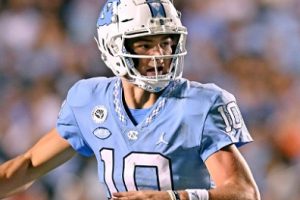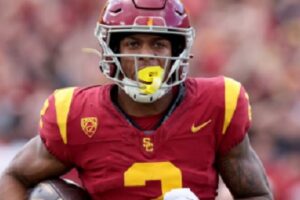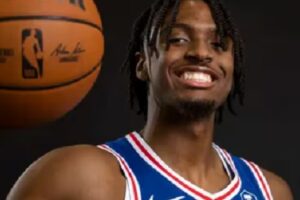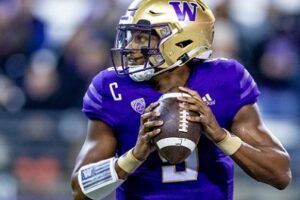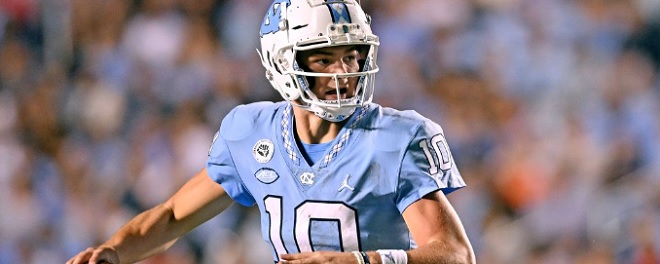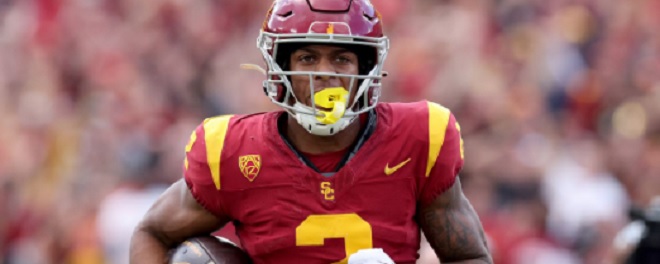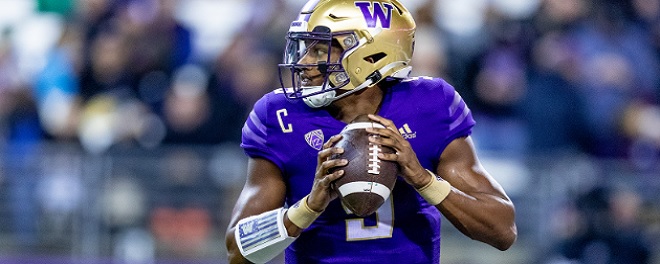This new section breaks down many college football games each week and highlights how 2012 NFL Draft Prospects have performed.
By Charlie Campbell.
Send Charlie an e-mail here: [email protected]
Follow Charlie on Twitter @draftcampbell for updates.


Arizona State 37, Missouri 30
There were a few quality prospects to watch in this game. Clearly the most recognizable is Arizona State linebacker Vontaze Burfict. The junior linebacker is considered to be one of the top linebackers in the 2012 NFL Draft, and a future first-round pick.
Burfict had a big game to start the season with three sacks against UC Davis. Against Missouri he had another good performance. Burfict was active and flying around the field, while also getting a lot of attention from Missouri. Their offense seemed to key on him and run their plays away from the star linebacker.
One of the criticisms of Burfict is that he is a headcase on the field who makes mental mistakes that result in unnecessary roughness and late-hit penalties. Burfict had that rear its head again when he recorded a penalty for throwing a receiver to the ground far away from the ball. There were also a couple of times were Burfict went for a knockout blow on a ball carrier instead of wrapping up for a tackle. That aggressiveness is part of his game, and as a pro he can be taught when to go for a big hit and when to wrap up a ball carrier.
Burfict recorded five tackles with a sack and a pass broken up. He injured his ankle on an extra point pile up, but had his ankle re-taped and returned to the game. His first play back he did a good job of picking up the tight end in pass coverage to cause an incompletion.
Arizona State did not blitz Burfict that much, despite his prowess as a pass rusher. On his sack, he easily shoved a running back out of his way to take quarterback James Franklin down for a 14-yard loss. One great attribute that Burfict has entering the NFL is he is very good as a pass defender. He roves the short to intermediate part of the field well and surmises the proper players to pick up in pass coverage. That ability will really appeal to NFL evaluators.
The 6-foot-3, 250-pounder can fit as a 4-3 or 3-4 linebacker. His intelligence and instincts are underrated because of the devastating hits he has put on players. He is an intimidating force on the field, and with good coaching at the NFL level, looks like he could be a special player.
Missouri has two defensive prospects worth looking at. Junior defensive end Brad Madison had a good start to his junior season with two sacks against Miami of Ohio. A year ago Madison had 7.5 sacks with 32 tackles, 11 tackles for a loss and two forced fumbles. Against Arizona State, Madison recorded only two tackles.
While his stat line wasn’t impressive, Madison had some good pass rushes and put some heat on the quarterback. Madison has a good get off and is a quality athlete. The 6-foot-4, 265-pound Madison has a good motor as evidenced by him pursuing receivers and ball carriers downfield. Madison has a good skill set and could develop into a quality prospect. Right now, he would be better off staying in school and improving rather than entering the 2012 draft early.
Another junior that could turn into a quality prospect is Missouri linebacker Zavier Gooden. He had a good game against Arizona State, and did a good job of following to the ball and tackling ball carriers. Gooden (6-2, 230) is a very good athlete and has good speed. He flies around the field and defends the perimeter well. Gooden needs to add some more strength as he is a drag-down tackler. That led to running backs finishing some runs well and falling forward for an extra couple of yards. Gooden has tools to develop into a more forceful tackler. Like Madison, Gooden would probably be better served by returning to school and not entering the 2012 draft.
On the offensive side of the ball, the prospect of note was tight end Michael Egnew. Entering the season, he was considered to be the top tight end in the 2012 draft class. Missouri did not target Egnew as much as one would expect. Last year, Egnew caught 90 passes for 762 yards and five touchdowns (8.5 yards per reception). Egnew made his 100th career reception in the first quarter. He had a nice running catch crossing the middle, with a linebacker trailing, in the first half. After that he caught a clutch touchdown pass late in the game.
Egnew was definitely not used enough by Franklin. Part of that could be that Egnew does not look very fast. He doesn’t seem to get separation from defenders in man coverage. He looks adept at finding soft spots in zone coverage. He finished the game with three catches for 27 yards and one score. With the decline in production, it wouldn’t be surprising if Egnew is bypassed by another tight end.


Alabama 27, Penn State 11
The Alabama defense is filled with NFL talent and, as a unit, they showed it with a dominant performance against Penn State. The Crimson Tide linebackers Nico Johnson, Courtney Upshaw, and Dont’a Hightower all had quality games. They all played well in run defense. Upshaw and Hightower both were able to get some pressure on edge rushes. All of those players had good games, but none of them produced massive stat lines.
Alabama cornerback Dre Kirkpatrick is viewed as one of the top cornerbacks in the nation. Assuming he declares for the 2012 draft, he is viewed as the top corner and a top-10 pick. Kirkpatrick showed why against Penn State.
Penn State threw at Kirkpatrick some and did not get good results. One play he could have been called for a holding penalty, but overall he had tight coverage and broke up a few passes. He made his best play in the second quarter when he got low on a tight end running with the football and made a big hit to force a fumble. That turnover led to an Alabama touchdown.
The 6-foot-3, 192-pound Kirkpatrick was called for pass interference later in the fourth quarter. It wasn’t a necessary shove to prevent an incompletion. A little bit later Kirkpatrick had another big hit that forced a fumble. The loose ball was recovered by safety Mark Barron. The play came when Penn State was putting together one of their best drives of the game, and it pretty much put the Alabama victory on ice.
Barron (6-2, 218) had a very good game and showed his top-notch instincts. He had some big hits in run defense and stayed around the ball as evident by his fumble recovery. Barron’s pass coverage was sound as well. He made a good read and undercut a deep pass to make a leaping interception. The pick took away a scoring opportunity for Penn State. Barron looks like he is staying steady as a second-rounder.
Rated higher than Barron, is free safety Robert Lester who is viewed as a first or second-round pick. He was tied for second in college football last season with eight interceptions. Against Penn State, Lester had two near interceptions but both balls were reviewed, and shown to have been trapped. Overall, Lester played a good game.
On the offensive side of the ball, the Crimson Tide draft prospects performed well. Alabama running back Trent Richardson gradually put together a quality game against Penn State. Early in the game Richardson was getting stuffed by the Penn State defense, but Richardson had some good physical runs in the second quarter. He dove in for a short touchdown late in the second quarter.
One aspect of Richardson’s game that will impress evaluators is his pass-protection skills. Richardson did a good job in blitz pickup. He made good reads and fit up well on defenders.
Richardson and the Alabama offensive line wore down the Penn State defense and started to rack up more yardage. In the fourth quarter, Richardson scored his second touchdown of the game on a 13-yard run where he ran threw a few arm tackles.
For the game, Richardson ran for 111 yards on 26 carries (4.3 average) with two touchdowns. Right now he hasn’t changed his status as a mid first-round pick.
The Alabama offensive line was led by left tackle Barrett Jones, center William Vlachos and right tackle D.J. Fluker; all had dominant games. They did not allow pass pressure and did a good job in run defense. Jones looks like a better guard at the next level. Both he and Vlachos should be second-day picks. Fluker has a super-high ceiling and is a prospect for the 2013 NFL Draft.
Penn State defensive tackle Devon Still, a mid-rounder, and defensive end Jack Crawford, a late-rounder, flashed well early in the game. Still had solid performance in run defense for the Nittany Lions.


Michigan 35, Notre Dame 31
Notre Dame linebacker Manti Te’o entered the season as a first-round pick. A week ago Te’o had nine tackles with a sack against USF.
Against Michigan, Te’o had his hands full trying to defend dual-threat quarterback Denard Robinson. There were times that Te’o was caught out of position by over pursuing Robinson, and Michigan used his aggressiveness against him. Te’o is a physical, in-the-box defender that attacks the line of scrimmage. Te’o doesn’t shy away from taking on linemen and is capable of shedding a block. It is too early in the season to downgrade Te’o for one average game, but he will need to perform better in the weeks to come.
Fighting Irish wide receiver Michael Floyd had his second straight impressive performance of the season. Floyd started the season by snatching 12 passes for 154 yards and two touchdowns against the Bulls. Floyd had no issues moving the chains against Michigan. He showed off impressive quickness and speed to rip off yards in chunks after the catch. The Wolverines couldn’t match up with him, and when Floyd wasn’t catching the ball he drew some pass interference penalties. The 6-foot-3, 218-pound Floyd looks explosive. His body control along the sideline is excellent and Floyd has very good hands. He had over 100 yards at halftime.
In the second half Michigan did a better job against Floyd, but the big wide out was still effective. He finished the game with 13 receptions for 159 yards. As a player he is definitely a first-rounder, but off-the-field problems are the big concern that could push him outside the top 32.


Texas 17, BYU 16
BYU left tackle Matt Reynolds had another quality game as a pass protector. Texas challenged Reynolds more than Ole Miss did a week ago, especially in run blocking. However with the exception of Reynolds allowing one tackle for a loss, he neutralized his defender on just about every play.
With ease, Reynolds was pushing linemen too far out and around the pocket to get any pressure on the quarterback. The 6-foot-6, 325-pound Reynolds is definitely a right tackle in the NFL. He would be ideal for a team that puts an emphasis on pass blocking on the second day of the draft.
Texas linebacker Keenean Robinson, a second-day pick, and linebacker Emmanuel Acho, a mid-rounder, had decent games and were around the ball. Robinson almost intercepted a pass midway through the fourth quarter. They both did a good job of run defense, especially in the second half.


Wisconsin 35, Oregon State 0
Early in the game Wisconsin’s vaunted running game was getting stifled by Oregon State’s defense. There weren’t running holes for running backs Montee Ball and James White. Junior center Peter Konz was beaten for a tackle for a loss and senior right tackle Josh Oglesby was beaten for a sack. Junior left tackle Ricky Wagner, sophomore guard Travis Frederick, and senior right guard Kevin Zeitler didn’t start the game as well either.
The pass blocking was better as senior quarterback Russell Wilson hooked up with senior wide out Nick Toon for a touchdown in the first quarter. The offensive line wore down Oregon State and was able to get Ball and White some room to run.
The junior Ball ended up running for two touchdowns in the second half. He ran for 118 yards on 18 carries (6.6 average) and two touchdowns. Ball now has six touchdowns on the season. White, a sophomore, ran for 53 yards on 17 carries. Toon had 69 yards and a touchdown on seven receptions.
Wilson is a gamer that combines a nice arm with good mobility. The reason why Wilson is not a real prospect is he is listed at 5-foot-11, and he could be shorter than his listed height.
Wisconsin has two more easy games before taking on Nebraska on the first Saturday in October. With the way he is playing right now, if Ball declares early for the draft he could be a second-day pick. That would be the case for Wagner as well. Zeitler looks like a second or third-rounder in next year’s draft.


South Carolina 45, Georgia 42
There were a number of future NFL players in the South Carolina vs. Georgia game. The top player among them was South Carolina wide receiver Alshon Jeffery. Jeffery was quiet in the first half, mainly because Stephen Garcia was playing poorly and not getting Jeffery the ball. That changed later in the second quarter when Garcia scrambled and tossed a bomb deep to Jeffery. The big wide out ran under the pass and slapped a defensive back away before hauling in the score. Jeffery’s 34-yard touchdown gave South Carolina a 7-6 lead.
At halftime, Jeffery had two catches for 49 yards and his score. In the second half, South Carolina continued to under utilize Jeffery. He did make a great leaping catch on a slant for a first down in the fourth quarter. For the game, Jeffery finished with five receptions for 85 yards. Despite the quarterback play, Jeffery is still projected to be a high pick in the first round.
Gamecocks defensive end Melvin Ingram continued an interesting season. Ingram is a defensive end on many running downs, but moves inside to rush from defensive tackle on many passing downs, while also moving to linebacker on occasion. The 6-foot-2, 276-pounder is a versatile defender that is not viewed as highly as teammate Devin Taylor, but Ingram has been more productive. Taylor is viewed as a first-rounder while Ingram is projected to be a second-day pick.
In the first game of the season, Ingram recorded an interception with a few tackles against East Carolina. Taylor had three tackles in the game.
Early in the first half Ingram got hurt and left the game, but he returned in the second quarter and made a huge play on special teams for South Carolina. On a fake punt just before halftime, he caught the snap as part of a personal-protector trio. Ingram ran 68 yards down the sideline for a touchdown. The speed that Ingram displayed on the run was extremely impressive. He looked like a natural ball carrier, not the player that was third in the SEC in sacks in 2010.
Ingram got back into the end zone to seal the win for South Carolina late in the fourth quarter. The Gamecocks were up 38-35 with just over three minutes left in the game. Freshman Jadeveon Clowney hit Georgia quarterback Aaron Murray forcing a fumble from an interior rush. Ingram was a couple steps behind and he scooped up the loose ball and ran it five yards for a touchdown.
He wasn’t done making big plays as he caught an onside kick from Georgia. The big defensive linemen did not have a big night sacking the quarterback, but he made huge plays that led to a win for South Carolina.
For the majority of the game Taylor was kept quiet, though he had an excellent rush in the third quarter that drew a holding call. However, Taylor exploded off the snap after lining up as a left defensive end.
Late in the fourth quarter, Georgia had a go-ahead touchdown run going right at Taylor. He was single blocked on the play by Bulldogs tight end Orson Charles. Taylor definitely needs to get more consistent in getting pass pressure and defending the run.
South Carolina cornerback Stephon Gilmore entered the game with a first-round grade. Gilmore allowed a reception for a first down, but on the next play he almost made a diving interception along the sideline. He read the play well and broke off his receiver to try and track down the pass in front of the receiver. Unfortunately for Gilmore, he couldn’t hold onto the pass.
In the second half, Gilmore had two noteworthy plays back to back. On the first, Gilmore was flagged for pass interference as he was all over the back of a receiver. On the next play, Georgia running back Isaiah Crowell fumbled the ball and Gilmore scooped up the loose all. He weaved his way down the field and dodged many would-be tacklers. Gilmore ran the ball 57 yards down to the Georgia five-yard line. It set up a touchdown run by Garcia and a lead for the Gamecocks.
Georgia cornerback Brandon Boykin is viewed as a second-day prospect and he had a mixed first half against South Carolina. Boykin dropped an easy interception that he should have caught on an overthrown pass. It could have been a pick six for the Bulldogs. On the positive side, Boykin returned a kick 37 yards and did record an interception on a Hail-Mary pass on the final play of the second quarter.
In the fourth quarter at a clutch time, Boykin made a fabulous kick return where he hurdled one would-be tackler and burst down the field. Boykin ran for 58 yards before he was brought down by a defender. Boykin had some quality coverage in the game, and still looks like a second-day pick.
A week ago Georgia offensive linemen Ben Jones and Cordy Glenn had rough games against Boise State. They allowed a lot of pass pressure and couldn’t contain the Broncos defensive linemen. Both players had better showings against South Carolina, Glenn in particular although he did get beat on Ingram’s fumble return for a touchdown. Georgia continues to play Glenn at left tackle, but he clearly is a better fit at guard. Right now they look like third or fourth-rounders.


North Carolina 24, Rutgers 22
One of the college football teams that features the most 2012 draft prospects is North Carolina. A year after sending a good crop of players into the NFL, the Tar Heels will put more players into the pro ranks next year from both sides of the ball. Their defensive front seven is especially loaded with talent.
Entering the season, North Carolina senior defensive end Quinton Coples is in the running to be the top defensive player selected next April. Last year, Coples had 10 sacks with 15.5 tackles for a loss, 59 tackles, and two forced fumbles. Coples got his season started with two sacks and three tackles against James Madison in the first game of the season.
Coples was getting tons of double teams against Rutgers. Despite them he was still getting some pressure on the quarerback. He needs to work on cutting back towards the interior of the line and not trying to come around the edge on the vast majority of his rushes. On one play where he wasn’t double-teamed, he shed the left tackle and cut to the inside to get a hit on the quarterback. The refs called Coples for a roughing the passer because he hit Rutgers quarterback Chris Dodd in the head with his hand. It probably should have been a non-call as Dodd did not go down and the hit on the helmet was above the face mask.
It was interesting to see North Carolina mix in a 3-4 defense. When they did that Coples played a five technique at defensive end and he did a good job in those sets. The 6-foot-6, 285-pound Coples could have the size and strength to play the five technique, so 3-4 defenses that are drafting in the top five could look at Coples for that role, especially if he adds 5-10 more pounds of muscle. In that regard, it would be similar to the Chiefs drafting Tyson Jackson with the third-overall pick in 2009.
Another projected first-rounder at the same position as Coples is junior defensive end Donte Paige-Moss. He had a quiet first game where he recorded only two tackles. Paige-Moss and Coples share snaps at right end. Through most of the game against Rutgers, Paige-Moss was held in check.
Late in the third quarter, he broke out with an impressive sack. Paige-Moss (6-4, 260) was able to split a double team between the left tackle and guard. He showed a relentless motor to keep pushing towards the quarterback before jetting through a crease between the linemen. Dodd stepped up in the pocket to avoid a blitzer and Paige-Moss cleaned it up with a good tackle on the quarterback.
Paige-Moss had a nice run stuff for no gain later in the fourth quarter. Outside of those plays he was relatively quiet. Paige-Moss needs to become more consistent and have a bigger impact on a down-by-down basis to be a high first-rounder. He has tons of physical talent and needs to turn that into production.
Defensive tackle Tydreke Powell (6-3, 310) showed some good run-stuffing ability against Rutgers. He was tough at the line of scrimmage and was effective at pushing the pocket. He caused an incompletion late in the first half by shoving a blocker into the quarterback.
Powell entered the game as a second day pick and that looks like the appropriate spot for him. He is a good run defender that can push the pocket, but he does not look like a good enough pass rusher to be a first-round pick.
One thing that hurts the stats for Paige-Moss, Coples, and Powell is that North Carolina employs a heavy rotation of linemen. They play eight defensive linemen, so that reduces the sack opportunities for all the linemen. The Tar Heels also mix in some 3-4 sets that put the ends in as five techniques. Powell goes to nose tackle in that package. Playing that style doesn’t help the sack numbers for the players on the line either.
Perhaps the most dynamic defender in the game was North Carolina linebacker Zack Brown. He is considered to be a first or second-round pick. He caused a sack with a superb speed rush on a blitz from the outside. Another blitz from the right side almost resulted in a sack fumble, but Dodd was able to step up in the pocket to avoid the rush.
One play that did not look good happened when Brown over pursued the fullback on a pass in the flat. The fullback cut inside of Brown and the linebacker missed an open-field tackle on third down. The fullback was able to run a few more yards to get the first-down yardage.
Otherwise, Brown showed good run and pass defense for North Carolina. The elite speed is clear with Brown, as he flies around the football field. Brown darted through the line to record a sack in the fourth quarter. Every time that he blitzed, he got pressure on the quarterback.
The 6-foot-2, 230-pound Brown looks like a better fit in a 4-3 defense as an outside linebacker. He could be a good fit in a Tampa-2 defense, but may be even better in a 4-3 attacking defense that blitzes their outside linebackers often.
On the offensive side of the ball, two wide outs had phenomenal games. North Carolina wide receiver Dwight Jones got the game started well and gave the Tar Heels an early lead with a 66-yard touchdown reception. Jones beat the defensive back on a go-route and showed good speed to run by the defensive back. At 6-foot-4, 225-pounds Jones has imposing size and presents a good target for the quarterback.
Jones� production is definitely hurt by Tar Heels sophomore quarterback Bryn Renner. The signal caller is too impatient in the pocket and doesn’t throw enough passes to Jones. Jones showed some good hands and concentration to catch passes thrown behind him. Despite Renner, Jones had a massive first half with five catches for 115 yards and a touchdown.
In the second half Jones only had one catch, but it was a nice one. The pass was high and Jones deflected the pass to himself. He corralled the ball and stumbled his way through a few players for a 20-yard gain. Jones finished the game with six receptions for 135 yards and one touchdown. A game like the one he produced against Rutgers will help cement his status as a second-day pick.
Jones wasn’t the only future NFL wide receiver in this game. Rutgers wide out Mohamed Sanu (6-2, 215) had a good game against North Carolina. Sanu made a nice catch on a hitch route for a fresh set of downs. He made a number of short receptions and is adept at working the short to intermediate part of the field.
Sanu had a drop just before halftime, but made up for it with a beautiful leaping one-handed catch in the end zone for an 18-yard score. On the play, Sanu jumped in the air and reached behind his head to snare the ball in his left hand. He pulled the ball into his body before landing on the ground. In the first half, Sanu caught six passes for 54 yards and the touchdown.
Sanu made another leaping clutch catch on a third down early in the fourth quarter. On the next possession he made another vital reception on a third-and-long to extend the drive. Sanu caught passes on three straight plays. North Carolina’s secondary had no answers and were ineffective in matching up on Sanu. He showed fabulous hands and is a dangerous weapon on third down. Sanu finished the game with 13 receptions for 119 yards and one touchdown.
Entering Saturday, Sanu was viewed as a second-round pick. If he keeps producing games like that throughout the season, he will make a push to be a late first-round pick.


Oklahoma State 37, Arizona 14
A major disappointment from a draft perspective was the absence of star Arizona wide receiver Juron Criner. He missed the game because of an appendectomy. In the first game of the season, Criner had six receptions for 151 yards. Right now he projects to be a second-round pick. Arizona is hoping that Criner will be back for their third game of the season.
Not having Criner was a detriment for Arizona quarterback Nick Foles. Entering the season Foles was viewed as a potential second-round pick. Foles (6-5, 235) has the arm, pocket presence and skill set to become a starting quarterback in the NFL. Last year, he threw for 3,191 yards with 20 touchdowns and 10 interceptions while completing 67 percent of his passes. Foles was consistent with his sophomore production when he completed 64 percent of his passes for 2,486 yards. He tossed 19 touchdowns and nine interceptions.
Foles completion percentage is inflated by the number of short-swing passes he threw. Plus he threw a lot of jump balls to Criner, and the wide receiver did a fabulous job of beating defensive backs for those passes. To start the season Foles had a massive game. He completed 34-of-42 passes for 412 yards with five touchdown passes as Arizona destroyed Northern Arizona 41-10.
Throughout the game against Oklahoma State, Foles completed a lot of quick one-read passes. He has the tendency to only look at one side of the field. He showed some good pocket mobility and presence to avoid sacks, and quality arm strength hit receivers on out-routes. Not having Criner was clearly hurting Foles, and the Arizona offensive line allowed some pressure.
Foles and Arizona were shut out in the first half. He led a good drive late in the second quarter. Foles made a big play where he avoided a sack and broke out of the pocket. Foles kept his eyes downfield and found a receiver open in zone coverage for a 27-yard gain. Arizona got inside the 10-yard line. They had some bad run calls when they should have given Foles some more opportunities. On fourth-and-goal Foles threw a bullet on a slant, but good coverage by Oklahoma State slapped the pass down for an incompletion.
In the third quarter, Foles got into a better grove and completed some nice passes to move the ball downfield and set up a short running touchdown. He stayed sharp and lofted a 54-yard touchdown pass to a wide open receiver early in the fourth quarter, but that made the score 14-34 in favor of Oklahoma State.
Foles finished the game completing 37-of-51 passes for 399 yards and one touchdown with zero interceptions. He made good decisions, but did not get the necessary help from his offensive line, wide outs, and defense to really compete with Oklahoma State. Foles will have some more challenges with Stanford, Oregon and USC upcoming on the schedule.
Foles definitely has some developmental talent. He’s got the size, arm, pocket mobility and pocket presence to be a starting quarterback in the NFL. Right now he does not look like a first-rounder because he needs to receive a lot of grooming in learning to scan a field, read a defense, and make his progressions as quickly as is required in the NFL. Too often Foles will stare down his first option. He doesn’t turn his head to other receivers unless he is pressured and the play breaks down, or he takes a deep drop and has all-day to throw the ball. Still, Foles has starting potential at the next level.
Quarterbacks rise in the draft, so if he has a good season it wouldn’t be surprising if some push Foles into the end of the first round. As a prospect, he really is a second-rounder right now.
The player that will almost certainly will get drafted the highest in this game is Oklahoma State wide receiver Justin Blackmon. Last year he was one of the most electric players in college football. Blackmon almost entered the 2011 NFL Draft but decided to return to the Cowboys. The 6-foot-1, 211-pound Blackmon was a dynamite playmaker in 2010. Blackmon combines good quickness, straight-line speed and route-running to constantly gain separation from defensive backs. He produced 1,782 yards on 111 catches with 20 touchdowns. He also was extremely consistent. Blackmon entered the game with 13 straight 100-yard games, including eight receptions for 144 yards last week.
Early in the game Blackmon made a quick impact. He had a fabulous cut block to spring a long run for running back Joseph Randall. Blackmon’s first catch went for 29 yards on a deep slant, and he finished the drive with a picturesque touchdown catch on a short fade pass to the back corner of the end zone.
Later, Blackmon threw a wicked spin move on a safety to avoid a tackle and break into the open field. He also took a big hit and all that seemed to do was fire him up. In the second half, Blackmon got hot and helped move the chains in the third quarter. He finished another drive with a fade touchdown reception. Blackmon is too quick and physical to be single covered like Arizona tried to defend him in the red zone.
He finished the game with 13 receptions for 133 yards and two touchdowns. Blackmon just gave another tape to NFL evaluators that proves he is a special player and a top-20 pick.
Oklahoma State quarterback Brandon Weeden entered the season as a mid-round prospect. Weeden had a mixed outing against Louisiana-Lafayette. The good results were he completed 24-of-39 passes for 388 yards and three touchdowns. The poor showing was throwing three interceptions to an inferior opponent.
One of the reasons why Weeden, 27 years old, is rated as a mid-rounder is because he will enter the NFL in his late 20s after playing pro baseball for a few years. Weeden carved up the Arizona secondary, and did it with relative ease. He completed 42-of-54 passes for 393 yards with two touchdowns and one interception. Weeden’s one interception came when he threw behind a receiver and was picked off at the Arizona five-yard line.
Weeden has a strong arm and is an accurate passer. Like Foles, Weeden has a tendency to look at one side of the field and stare down his primary wide receiver. Weeden (6-4, 213) will have to be developed to read the field and make his proper progressions. His age is considered a real detriment to his draft stock, and basically forces him to be a mid-rounder.
Another draft prospect that had a good game for Oklahoma State was left tackle Levy Adcock. The 6-foot-6, 322-pound Adcock did a good job in pass protection for the Cowboys. He also was a good run blocker. At the NFL level, Adcock would probably be better used as a right tackle. He allowed some pressure, and his feet might not be quick enough to handle NFL speed rushers. Perhaps if he dropped some weight, he would be a more viable left tackle. At this time Adcock looks like a second-day pick.
|
|
2024 NFL Mock Draft - April 16
NFL Power Rankings - Feb. 22
Fantasy Football Rankings - Feb. 19
NFL Picks - Feb. 12

